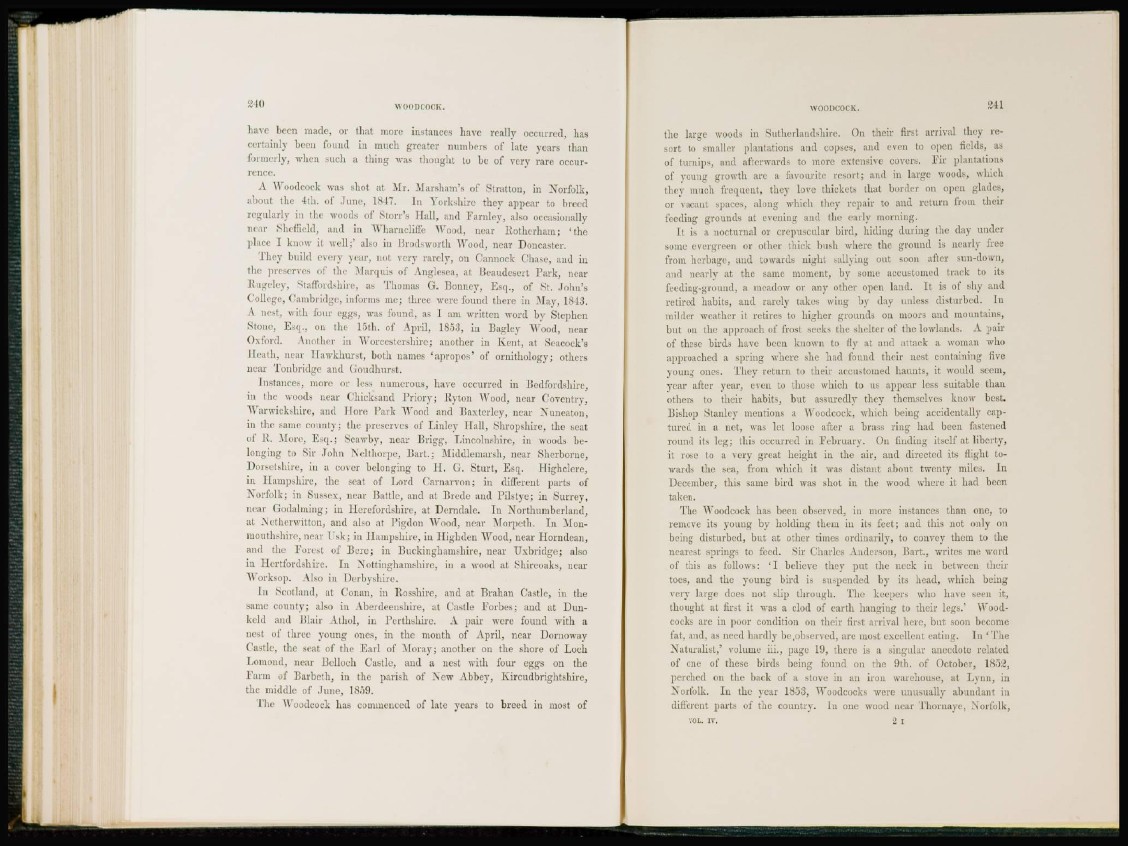
210 WOODCOCK.
have been made, or that more instances have really occurred, has
certainly been lb mid in much greater numbers of late years than
formerly, when such a thing was thought to be of very rare occurrence.
A Woodcock was shot at Mr. Marsham's of Stratton, in Norfolk,
about the 4th. of June, 1847. In Yorkshire thev appear to breed
regularly in the woods of Storr's Hall, and Farnley, also occasionally
near Sheffield, and in AYharncliffe Wood, near Rotherham; ' the
place I know it well;' also in Brodsworth Wood, near Doncaster.
They build every year, not very rarely, on Cannock Chase, and in
the preserves of the Marquis of Anglesea, at Beandesert Park, near
Etugeley, Staffordshire, as Thomas G. Bonncy, Esq., of St. John's
College, Cambridge, informs me; three were found there in May, 1843.
A nest, with four eggs, was found, as I am written word by Stephen
Stone, Esq., on the 15th. of April, 1853, in Bagley Wood, near
Oxford. Another in Worcestershire; another in Kent, at Seacock's
Heath, near Ilawkhurst, both names 'apropos' of ornithology; others
near Tonbridge and (ioudhurst.
Instances, more or less numerous, have occurred in Bedfordshire,
in the Moods near Chick sand Priory; Ryton Wood, near Coventry,
Warwickshire, and Hore Park Wood and Baxterley, near Nuneaton,
in the same county; the preserves of Linley Hall, Shropshire, the seat
of 11. More, Esq.; Scawby, near Brigg, Lincolnshire, in woods belonging
to Sir .John Nelthorpe, Bart.; Middle marsh, near Sherborne,
Dorsetshire, in a cover belonging to H. G. Sturt, Esq. Highclere,
in Hampshire, the seat of Lord Carnarvon; in different parts of
Norfolk; in Sussex, near Battle, and at Brede and Pilstye; in Surrey,
near Godahning; in Herefordshire, at Derndale. In Northumberland,
at Netherwitton, and also at Pigdon Wood, near Morpeth. In Monmouthshire,
near Usk; in Hampshire, in Highden Wood, near Horndcan,
and the Forest of Bere; in Buckinghamshire, near Uxbridge; also
in Hertfordshire. In Nottinghamshire, in a wood at Shireoaks, near
Worksop. AIso in Derbyshire.
In Scotland, at Conan, in Rosshire, and at Brahan Castle, in the
same county; also in Aberdeenshire, at Castle Forbes; and at Dunkcld
and Blair Athol, in Perthshire. A pair were found with a
nest of three young ones, in the mouth of April, near Dornoway
Castle, the seat of the Earl of Moray; another on the shore of Loch
Lomond, near Belloch Castle, and a nest with four eggs on the
Farm of Barbeth, in the parish of New Abbey, Kircudbrightshire,
the middle of June, 1859.
The Woodcock has commenced of late years to breed in most of
WOODCOCK. 211
the large woods in Sutherlandshire. On their first arrival they resort
to smaller plantations and copses, and even to open fields, as
of turnips, and afterwards to more extensive covers. Fir plantations
of young growth are a favourite resort; and in large woods, which
they much frequent, they love thickets that border on open glailes,
or vacant spaces, along which they repair to and return from their
feeding grounds at evening and the early morning.
It is a nocturnal or crepuscular bird, hiding during the day under
some evergreen or other thick bush where the ground is nearly free
from herbage, and towards night sallying out soon after sun-down,
and nearly at the same moment, by some accustomed (rack to its
feeding-ground, a meadow or any other open land. It is of shy and
retired habits, and rarely takes wing by day unless disturbed. In
milder weather it retires to higher grounds on moors and mountains,
hut on the approach of frost seeks the shelter of the lowlands. A pair
of these birds have been known to fly at and attack a woman who
approached a spring where she had found their nest containing five
young ones. They return to their accustomed haunts, it would seem,
year after year, even to those which to us appear less suitable than
others to their habits, but assuredly they themselves know best.
Bishop Stanley mentions a Woodcock, which being accidentally captured
iu a net, was let loose after a brass ring had been fastened
round its leg; this occurred in February. On finding itself at liberty,
it rose to a very great height in the air, and directed its flight towards
the sea., from which it was distant about twenty miles. In
December, this same bird was shot in the wood whore it had been
taken.
The Woodcock has been observed, in more instances than one, to
remove its young by holding them iu its feet; and this not only on
being disturbed, but at other times ordinarily, to convey thein to the
nearest springs to feed. Sir Charles Anderson, Bart., writes ine word
of this as follows: ' I believe they put the neck iu between their
toes, and the young bird is suspended by its head, which being
very huge does not slip through. The keepers wdio have seen it,
thought at first it was a clod of earth hanging to their legs.' Woodcocks
are in poor condition on their first arrival here, but soon become
fat, and, as need hardly be .observed, are most excellent eating. In ' T he
N a t u r a l i s t / volume iii., page 19, there is a singular anecdote related
of one of these birds being found on the 9th. of October, 1852,
perched on the back of a stove in an iron warehouse, at Lynn, in
Norfolk. In the year 1853, Woodcocks were unusually abundant in
different parts of the country. In one wood near Thornayc, Norfolk,
VOL. IV. 2 I